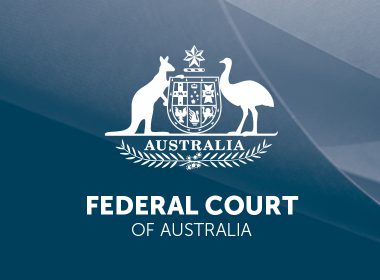Key decisions
- Commonwealth of Australia v De Pyle [2024] FCAFC 43 (Vincci Chan)
- Lehrmann v Network Ten Pty Limited [2024] FCA 369 (Joanne Shepard)
PRACTICE AND PROCEDURE
Interlocutory application by Commonwealth for certain suppression orders – orders necessary to prevent prejudice to national security and to protect safety of person not contradicted
Commonwealth of Australia v De Pyle [2024] FCAFC 43 (O’Callaghan, Raper and Button JJ)
The respondent (‘Mr De Pyle’) was a former member of the Australian Defence Force (‘ADF’) and commenced proceedings in the Federal Court of Australia, claiming to have been subject to unlawful discrimination by the Commonwealth during ‘Conduct After Capture’ (‘CAC’) training which he participated in March 2019 as an ADF member. During those proceedings, the Commonwealth sought suppression and related orders over certain information relating to the ADF’s CAC training contained in documents filed in the proceeding pursuant to section 37AF of the Federal Court of Australia Act 1976 (Cth) (‘FCA’). The documents included Mr de Pyle’s complaint to the Australian Human Rights Commission (‘AHRC’); originating application and annexure; concise statement; and the Commonwealth’s concise response.
At the commencement of the hearing of the suppression order application, the Australian Broadcasting Corporation (‘ABC’) intervened pursuant to s 37AH(2)(d) of the FCA and submitted that the certain matters in respect of which the Commonwealth sought suppression orders were in the public domain. Mr De Pyle neither supported nor opposed the suppression orders.
The primary judge refused the suppression orders on the basis that certain content was in the public domain, or that confidentiality of the subject content had been lost and therefore there was no necessity nor utility for protection of the Commonwealth’s response to the content.
The Commonwealth appealed pursuant to s 24(1) of the FCA, contending the primary judge erred in her findings in relation to each document or subject content in question.
The Court’s findings
The Court of Appeal allowed the appeal and dismissed the ABC’s notice of contention.
After considering ss 37AA, 37AE, 378AF and 374G of the FCA and the relevant principles including open justice (at [26]-[28]), the Court made the following findings:
- Since this was an appeal by way of re-hearing, the Court was required to consider ‘both suggested errors of law and fact and, where appropriate, draw inferences and conclusions from the evidence, so as to give the judgment which in its opinion ought to have been given in the first instance (Astrazeneca Pty Ltd v Glaxosmithkline Australia Pty Ltd [2006] FCAFC 22 (at [32]); CSR Ltd v Della Maddalena (2006) 224 ALR 1; [2006] HCA 1 at [16]; Fox v Percy (2003) 214 CLR 118 at [22]-[23])’ (at [39]).
- With respect to Mr de Pyle’s complaint to the AHRC, this did not form part of an originating application, and therefore leave was required to inspect it (Oldham v Capgemini Australia Pty Ltd [2015] FCA 1149 at [23]). The complaint could therefore not be said to be in the public domain by virtue of it being filed and available for inspection by non-parties (at [44]). Moreover, a news article stating that Mr Pyle had shared a letter from the AHRC declining to investigate his complaint did not mean that the complaint itself was also shared (at [45]).
- With respect to the remaining material, the question of whether same was in the public domain could not ‘be answered simply by the fact that it was available for inspection on a court file, electronic or otherwise’ (at [46]). The relevant Federal Court Rules (e.g. rule 2.32) ‘provide that certain documents were available to the public – not that they are taken to have been accessed or disseminated.’ Read in context, the rules do not operate as ‘some kind of deeming provision, precluding suppression orders in respect of documents that are the subject of a presumptive right of access’ (at [49]).
- In considering whether to make a suppression order in respect of a document said to be in the public domain, it was necessary to consider the extent of actual dissemination (Commissioner of Police NSW v Nationwide News Pty Ltd (2008) 70 NSWLR 643 at [43]; Eastman v Director of Public Prosecutions (No 2) (2014) 9 ACTLR 178 at [188]). The question of whether it is futile to make a suppression order because of its public disclosure depends upon the degree of such disclosure (at [50] and [51]). ‘Here, there was no evidence of the extent of the dissemination of, or access to, any relevant document’ (at [52]).
- The primary judge’s finding that, once the confidentiality of the subject content had been lost, there was no necessity nor utility for protection of the Commonwealth’s response to that content, amounted to ‘saying that because an allegation is in the public domain, then public confirmation of whether or not that allegation is right or wrong cannot be protected.’ The primary judge did not consider the Commonwealth’s submission that its response to something could not be conflated with ‘the mere allegation about something’ (at [54]).
- The primary judge overlooked an email that contained a version of the documents in which the parties had agreed what was already in the public domain and what was not. That email highlighted information in yellow that was not disclosed by the evidence to be in the public domain. Highlighted in blue was material the ABC considered was in the public domain but the Commonwealth did not agree was in the public domain.
- ‘[B]ecause the hearing was conducted by the parties on the basis that the Commonwealth was entitled to a suppression order in respect of any materials not in the public domain, and those parts of the materials highlighted in yellow were agreed not to be in the public domain, the email is a concession by the ABC, from which it now cannot resile, that the Commonwealth is entitled to the suppression orders… over the highlighted passages of the email (subject to the Court being satisfied that the orders are “necessary”) [pursuant to FCA s 374G]’ (at [58] and [59]).
- The overlooking of the email was a sufficient basis to allow the appeal (at [55]-[65]).
- The Commonwealth had established that the making of the suppression orders was necessary with respect to the yellow highlighted material. The Court ‘must give very considerable weight to the view of what national security requires as is expressed by the responsible officer’ (Alister v The Queen (1984) 154 CLR 404 at 435; Parkin v O’Sullivan (2009) 260 ALR 503; [2009] FCA 1096 at [30]) (at [68] -[72]).
- With respect to the blue highlighted material, the only question was whether and to what extent that material was in fact in the public domain. This was a fact-finding task, not one for an appeal court (at [76]-[78]).
Accordingly, suppression orders were granted in relation to the yellow highlighted material; the proceedings were remitted to the primary judge to determine the question in relation to the blue highlighted material; and interim suppression orders were made until that question was determined.
The Court ‘must give very considerable weight to the view of what national security requires as is expressed by the responsible officer’.
DEFAMATION
Identification – defences – substantial truth – s 25 Defamation Act 2005 (NSW) – statutory qualified privilege – s 30 Defamation Act – defence of substantial truth established
Lehrmann v Network Ten Pty Limited [2024] FCA 369 (Lee J)
In his introductory comments, Lee J described the case as a cause célèbre and, famously, as an omnishambles. Noting how the case had become a proxy for wider political and cultural conflicts, his Honour embarked on the task which, in his words, was ‘to set out [his] factual findings comprehensively and explain [his] decision to the parties and to the open and fair-minded’.
Background
Mr Bruce Lehrmann claimed Network Ten and Ms Lisa Wilkinson (‘respondents‘) published defamatory material in an episode of Network Ten’s ‘The Project’ programme which aired and was published online on 15 February 2021. Mr Lehrmann alleged the programme conveyed four imputations: first, Mr Lehrmann raped Ms Brittany Higgins in Defence Minister Linda Reynolds’ office in 2019; secondly, Mr Lehrmann continued to rape Brittany Higgins after she woke up mid-rape and cried, and told him to stop at least half a dozen times; thirdly, Mr Lehrmann, whilst raping Brittany Higgins, crushed his leg against her leg so forcefully as to cause a large bruise; and fourthly, after Mr Lehrmann finished raping Brittany Higgins, he left her on a couch in a state of undress with her dress up around her waist.
The respondents denied the matters concerned Mr Lehrmann (that is, they maintained the programme did not identify him) but, if they did, the respondents admitted that the pleaded imputations were conveyed and defamatory. The respondents raised defences including substantial truth and qualified privilege defences pursuant to sections 25 and 30 of the Defamation Act 2005 (NSW) (‘Act’), respectively.
Factual complexity arose in respect of the primary defence of truth which, in his Honour’s words, resulted in the case becoming ‘a credit case’ involving two people who were both, in different ways, ‘unreliable historians’ (at [8]). In this respect, his Honour outlined a number of principles relevant to receiving evidence including with respect to the effect of trauma. Numerous ancillary factual assertions were canvassed to assess the reliability or otherwise of the two main witnesses, including as to their statements regarding the provision and use of certain protected documents and whether there was a political cover up by those in the office of the Defence Minister.
The central issues and judicial conclusions
Identification
Lee J was satisfied the programme was capable of identifying Mr Lehrmann given the extraneous details provided: he was a senior male adviser advising Senator Reynolds, he attended drinks with Defence colleagues on the relevant night, he met with Ms Fiona Brown the following morning and he subsequently left his employment. Lee J was further satisfied that the programme did, in fact, identify Mr Lehrmann.
Substantial truth defence
To establish a defence under section 25 of the Act, the respondents were required to prove the substantial truth of each imputation, meaning that, on the balance of probabilities, it was true in substance or not materially different from the truth. Lee J reviewed contemporaneous records, including security and CCTV footage; telephone and text records; and contemporaneous notes, and compared those to contemporaneous statements made by Ms Higgins and Mr Lehrmann.
His Honour was satisfied, contrary to statements made by Mr Lehrman after the incident and in his evidence-in-chief, that Mr Lehrmann: encouraged Ms Higgins’ consumption of alcohol; engaged in consensual physical touching and kissing with Ms Higgins at a bar; was aware that Ms Higgins was inebriated and that this would lower her inhibitions and impair her judgment; returned to Parliament House signing in both Ms Higgins and himself; and had not returned to Parliament House to note up briefs for question time (which was the reason for Mr Lehrmann’s return to Parliament House given by him at trial). Further, his Honour was satisfied that Ms Higgins was in a state of undress and ‘discombobulated’ at the time security conducted a welfare check on her after seeing Mr Lehrmann leave Parliament House without her (at [509]). Lee J also placed significant reliance on contemporaneous notes made by Ms Fiona Brown, Senator Reynolds’ Chief of Staff, which records, in the days following, Ms Higgins disclosure that she had woken up ‘semi-naked’ and that she recalled Mr Lehrmann being on top of her (at [641]). This and other evidence led his Honour to conclude, on the balance of probabilities, sexual intercourse had taken place.
The respondents were further required to establish that rape had occurred based on its natural and ordinary meaning (and not that Mr Lehrmann had breached a specific criminal provision). In this respect, his Honour determined Mr Lehrman had raped Ms Higgins in circumstances where he had sexual intercourse with her, without her consent and knowing that she did not consent. Lee J did not accept Ms Higgins’ evidence that she made clear verbal protests during the incident. However, his Honour was satisfied, based on a number of surrounding facts and particularly Ms Higgins’ oral evidence, that she was not fully aware of her surroundings but then suddenly became aware of Mr Lehrmann on top of her, at which time he was performing the sexual act. On this basis, Lee J was satisfied that Ms Higgins had not consented to intercourse. Further, Lee J was satisfied Mr Lehrmann was ‘hell bent’ on having sex and was recklessly indifferent to whether Ms Higgins consented or not (at [601]).
Lee J considered the four imputations pleaded by Mr Lehrmann did not differ in their essential substance and their defamatory sting was that Mr Lehrman raped Ms Higgins in Parliament House. Having established this fact, his Honour was satisfied that the defence of substantial truth had been made out.
Statutory Qualified Defence
Section 30(1)(c) of the Act provides a defence for the publication of defamatory matter if, among other things, the respondent proves their conduct in publishing the matter was ‘reasonable in the circumstances’. Reasonableness in the circumstances includes such things as the public interest in receiving the information and the integrity of its sources (s 30(3)). Lee J construed ‘reasonableness’ in relation to the publisher’s conduct as the character of making the imputation complained of and not in publishing the matter in all respects. His Honour determined the respondents had not been reasonable in circumstances where the rape allegation was intertwined with the allegations of a ministerial cover up for which there was no basis and little investigation.
Damages
Lee J determined, if it had been necessary to assess damages in favour of Mr Lehrmann, the appropriate and rational relationship between the actual harm sustained and the damages awarded would lead to total damages of $20,000.
Concluding remarks
His Honour’s conclusion commences with the words: ‘[h]aving escaped the lions’ den, Mr Lehrmann made the mistake of going back for his hat’. In the result, his Honour stressed that Mr Lehrmann was not convicted of any offence (having escaped that lion’s den) but Mr Lehrmann has now been found, by the civil standard of proof, to have engaged in a great wrong which was the sexual assault of Ms Higgins.




